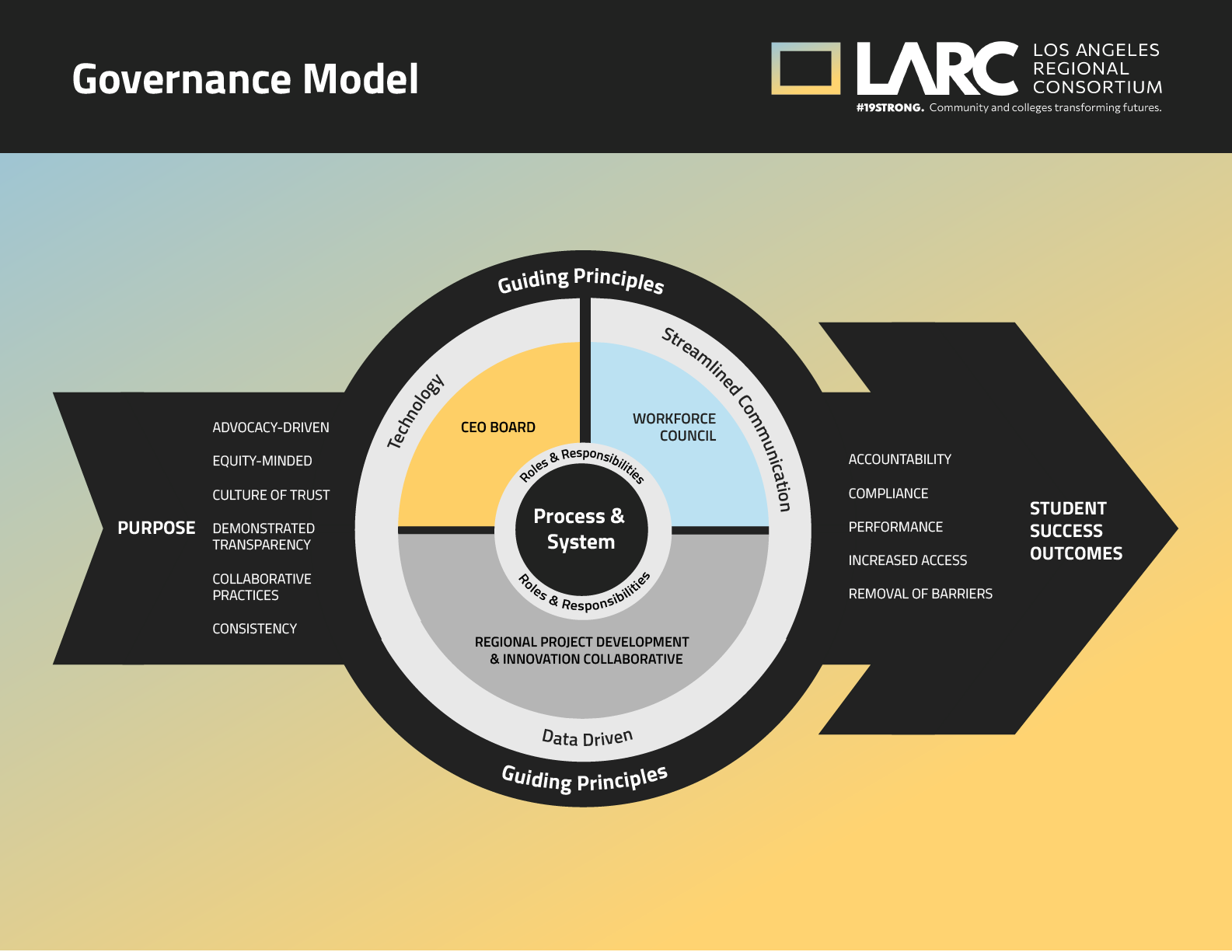Governance Model & Structure
Collaborative. Transparent. Successful.
Pasadena City College was selected by the colleges in the region as LARC’s fiscal agent and convened workforce and economic development stakeholders in a facilitated dialogue to establish a governance structure that is transparent and accessible for all voices to be heard. The result is a forward-facing governance model that reflects the needs and desires of the region and enables the work of the consortium to be carried forward in a collaborative and transparent manner, befitting a successful regional consortium.

Our Model

The Governance Model demonstrates the mechanism used by the consortium to translate the elements of the governance framework. It leads with guiding principles for inputs and additional guiding principles for outputs. Additionally, there are support practices, procedures, and responsibilities detailed within the model.
Guiding Principles for the inputs (Purpose):
- Advocacy-Driven
- Equity-Minded
- Culture of Trust
- Demonstrated Transparency
- Collaborative Practices
- Consistency
Guiding Principles for the outputs (Student Success Outcomes):
- Accountability
- Compliance
- Performance
- Increased Access
- Removal of Barriers
Woven throughout the Governance Model is the intent to leverage technology to achieve optimal results, streamline communication throughout the region, and actively engage in practices that result in data-driven decision making and reporting at all levels.
Responding to the defined needs of the region, overarching goals of the Governance Structure include the following:
- Increased effectiveness
- Improved coordination
- Improved clarity
- Greater visibility with the State
- Improved communication
Our Structure

The LARC Governance Structure was designed from inputs received from the field, key stakeholders, and in conjunction with research and study of multiple governance structures across the country and outside of the U.S.
Elements to the Structure
Regional Project Development and Innovation Collaborative:
The Regional Project Development and Innovation Collaborative shall serve as a framework for regional project development, industry engagement, and workforce alignment. All relevant stakeholders participate in a single collaborative body throughout project development.
The collaborative body is composed of, but not limited to, representatives from the CEO Board, designated alternate members of the board, members of the Workforce Council, Chief Instructional Officers, Vice Presidents, college leadership, deans, faculty, career services staff, project leads, LA Center of Excellence (COE), employers, industry representatives, LARC K14 Technical Assistance Provider (K14 TAP), and LARC K12 Pathway Coordinators. Relevant individuals or entities interested in participating are permitted to attend meetings and propose projects for CEO Board and Workforce Council consideration.
All regional project ideation and development is informed by labor market data, regional workforce needs, Strong Workforce metrics, employer engagement, LARC regional plans, COE sub-regional profiles, Vision 2030, the CTE Master Plan, and additional strategic input from the Workforce Council and CEO Board.
All proposed regional projects are presented first to the Workforce Council and second to the LARC CEO Board for feedback. The Workforce Council provides formal recommendations to the CEO Board regarding regional project funding, and the CEO Board issues final approvals for regional project proposals and budgets.
Workforce Council:
The Workforce Council serves as the Endorsement/decision-making body of the Governance Structure. The voting members of the Workforce Council are the 19 CEO-appointed CTE Deans and CIOs representing regions 6, 7, and 8. Non-voting members are all CE Partners.
- Recommend, review and approve new/modified CTE degrees and certificates through the program review process.
- Review/endorse annual work plans/budgets that are specific to the region.
- Review/endorse funding and region-wide project recommendations to the CEOs.
- Develop and champion regional projects.
- Review/evaluate region-wide project performances.
- Review/approve the region’s priority and emerging clusters.
- Participate in K-12 SWP activities/decisions, as appropriate.
- Participate in 360 personnel evaluation for LARC Consortium Chair/Associate Vice President and LARC support talent.
The Workforce Council is committed to acting in the best interest of the region. Members of the council agree to the following:
- Provide leadership and support for regional efforts.
- Promote regional collaboration.
- Seek input from constituents and experts in order to make informed decisions.
- Promote & Demonstrate open communication and transparency between the council, colleges and stakeholders.
- Attend Workforce Council meetings.
- Act as a liaison to their college leadership, faculty and staff.
The Workforce Council has the ability to create Task Forces for the purposes of researching, reporting, and finding solutions to ongoing issues within the region. Task Forces are considered subsets of the Workforce Council.
CEO Board:
The CEO Board consists of 19 College Presidents and LACCD Chancellor within the Los Angeles region. The CEO Board serves as:
- The advice and consent body of the consortium, allowing for direct feedback on projects and an opportunity for iterations of projects to happen in a timely, efficient, and effective manner. AND final approver of projects endorsed by the workforce council once any iterations are completed.
- Final approver to the distribution formula for the Strong Workforce regional funds and regional plans.
- Participate in 360 personnel evaluation for LARC Consortium Chair/Associate Vice President.
- Appoints a CTE Dean as a college representative to the Workforce Council.
A key function of this body is to advocate on behalf of the consortium. The importance of this role cannot be overstated, particularly as it relates to removing barriers for the consortium to achieve its overarching goals and for students making their way through the community college system. This work is undertaken by a CEO Action Coalition, which is led by the LACCD Chancellor in collaboration with college Presidents and employer CEOs, who address issues of public policy and systemic barriers as they relate to equity, economic empowerment, and education.
Support to the structure:
The effort of these Workgroups is supported by the Employer Engagement Plan, outreach efforts, student panel input, Los Angeles Centers of Excellence, the Office of Institutional Effectiveness Data Taskforce, and the Center for a Competitive Workforce (CCW).
The Employer Engagement Plan: Assess current baseline information and set clear outcomes and outputs supported by a robust framework for monitoring, self-evaluation and action planning. It aims to support increased employability for students and to effectively respond to employers’ needs.
Faculty/Employer Innovation Hubs: Populated by CCC administration, faculty, workforce boards, AJCC’s, community-based organizations and both public and private industry partners. Each Hub engages with, solicit ideas from, and builds alignment and commitment from a complex network of both regional and local stakeholder groups. These stakeholders include the Senate Presidents, Senate Faculty Committees, ASCCC Executive Council, Curriculum Committees, Discipline Committees, Organizational Effectiveness, CE Deans, and Vice Presidents.
Faculty Innovation Hubs primarily focus on three priority goals:
- Building a “gathering space” for regional faculty leaders.
- Develop solutions responsive to the COVID-19 and other concerns cited in the Burning Glass report: “After the Storm: The Jobs and Skills that will Drive the Post-Pandemic Recovery.”
- Creating a Badge System for faculty professional development.
Student Panels: Students from around the region participate in monthly discussions around key issues facing community college students. Their voices aid in the decision-making process and provide project validation/relevance. The panel integrates students into the CTE program design process to identify needed system improvements and ultimately advocate for the policy and practice changes they want to see.
Center of Excellence (COE): Hosted at Mt. San Antonio College, the Center of Excellence provides invaluable labor market research and the LARC will continue to rely on this research to guide and inform its work.
Office of Institutional Effectiveness Task Force: Representatives from each of the 19 community colleges Institutional Effectiveness focus on finding solutions to data gaps and assisting with the centralization and standardization of data within the region.
Feedback and evaluation for continuous improvement
At the core of continuous improvement, LARC must work at creating an improvement culture rooted in three practices:
- Ensuring Regional Performance transparency starts with publicizing regional goals then tailoring them to individual colleges. Progress toward those goals will be transparently tracked on the LARC data dashboard.
- Knowledge sharing to scale best practices across colleges. Bringing together regional subject matter experts will promote informal and formal knowledge sharing and facilitate relevant exploration while building shared accountability among all groups.
- Stakeholder involvement with regional stakeholders to capture their perspectives and insights.
The LARC Program Managers evaluate the progress of projects and are the key to continuous improvement. Among other objectives, their work ensures that project objectives are aligned with regional goals; that the purpose of the project allocations are fulfilled, and that grant activities are consistent with state legislation, standards and procedures. Their overarching obligation is to assess LARC successes, gaps, barriers, best practices, effectiveness, and compliance.
Our Bylaws
Read the current bylaws of the Los Angeles Regional Consortium (LARC).
